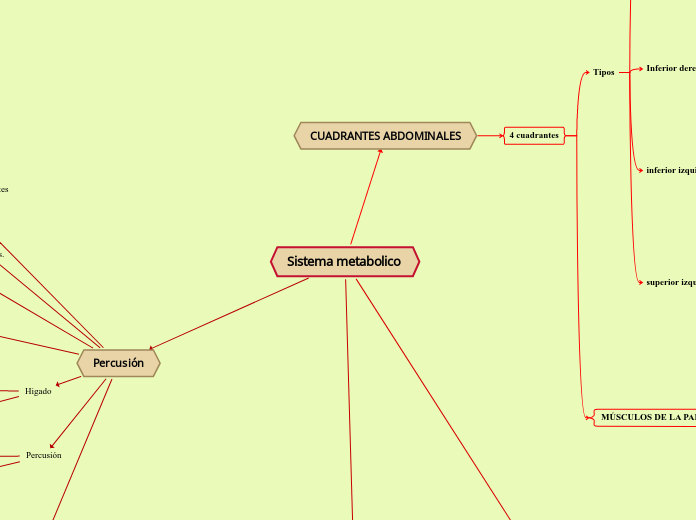por Alexander Loyo hace 4 años
332
Sistema metabolico

por Alexander Loyo hace 4 años
332

Ver más

To name your story, you have to think about the overall message and what you want your audience to understand from the story. Also, make it relevant and easy to remember.
Masas
Conciencia
Dolor
The ending of a story is essential. We all know that if the ending is weak, what happened before loses its importance. So make it unpredictable, but fair. A resolved ending answers all the questions and ties up any loose threads from the plot.
No se escucha soplos de la aorta abdominal
Ruidos vasculares estetoscopio presenca de soplos vasculares sobre la aorta abdominal y las arterias
24 a 48 horas para el baciamiento gastrico
Chasquidos y gorgoteos con una frecuencia de 5- 30 por minuto.
Delgado y pequeños
Invertido o protrusión no mayor de 0,5 cm, redondo y crónico.
Rosado
Las estrías rosadas con tonalidad azul
La coloración púrpura en flanco
Deprimido, localizado en centro
Linea media
Subtopic
Venas delgadas dispersas
Sin exantemas ni lesiones
This is the closure section of the story.
See examples of possible outcomes below:
Outcomes
Try answering these questions to come up with a closure:
- Have all the problems been solved?
- Is there a clear picture of what happens with each character in the story?
- Has the challenge transformed your main character?
- How do the characters feel in the end?
estrías.
La piel suele ser más pálida y presentar
This is the moment when the main character surpasses the last obstacle and finally faces their greatest challenge.
The climax usually follows one of these patterns:
Type in your answer.
Color
The middle of the story is where you add layers of complications that will lead to the end. Reveal more about the character's journey. Did their personality go through changes? How did they overcome the challenges? And as you build up the story’s central conflict, make it more personal to that character. Also, from the middle act, you have to lead into the final act.
There wouldn't be any tension and excitement in your story if there weren't any obstacles in your character's way.
Riesgo de canseres
Contacto sexual con portadores de VH
A story is nothing more than a character overcoming a series of difficulties to reach the desired goal. Obstacles usually create suspense and conflict. In overcoming obstacles, there is growth: weak becomes strong; hatred turns into love; sadness into happiness; wrong into right; lies into truth; or evil becomes good.
See a few examples below:
Indigestión, nauseas, vomitos, factores, , perdidad peso.
Tipo, inicio, ubicación, duración, intensidad, factores que alivian o empeoran
Your character(s) need(s) motivation in order to solve the challenge(s).
Why does your character need to confront this challenge? What does he/she expect to accomplish by solving it?
See a few examples:
Each story has a main character and that character usually needs to solve a problem or challenge. The character's challenge is the one that creates tension throughout the story.
In most stories, there are 3 challenges. The number 3 is a mystical number symbolizing completeness. Try to come up with interesting challenges with which your character needs to struggle.
See a few examples below:
In the beginning of the story (or the exposition), you will need to introduce the setting and characters. You might also want to introduce the main conflict. This part of the story is important because it gives the reader necessary background information and maybe even a first insight into a character’s personality.
Characters are essential to a good story. Usually, the protagonist(s) is/are the most affected by the plot. Introduce a character by focusing on their actions, interests, and occupation, as the physical appearance doesn't make a difference in most cases.
The setting (time & place) of a story can change throughout the plot.
Tres capas
Al extremo de oblicuo
Oblicuo interno
Sensory details include sight, sound, touch, smell, and taste. These details are important because they create depth in your setting.
See a few examples below:
Alrededor de los flancos
Time
The time of the story can also change. It can describe the event of a single day or can include an entire year's plot. Anyway, don't forget to mention it.
Time of plot
Where does the story takes place?
Your story can take place wherever your imagination will take you to.
For example: in an elevator, in an enchanted forest, etc. Don't forget to give details of the environment each time the setting changes, otherwise, the story can be confusing. Also, mention the seasons as each of them has unique weather and events.
Location
Type in the name of your character.
superior izquierdo
Add other qualities/attributes of the character.
Glándula suprarrenal izquierda Riñón izquierdo (polo superior) Uréter izquierdo Páncreas (cuerpo y cola) Bazo Ángulo esplénico del colon Estómago Colon ascendente transverso
inferior izquierdo
What is your character's main goal?
Riñón izquierdo (polo inferior) Tuba y ovario izquierdos Uréter izquierdo Cordón espermático izquierdo Colon sigmoideo
Inferior derecho
Which traits best describe the character's personality? Choose more if necessary:
Apéndice Colon ascendente Ciego Riñón derecho (polo inferior) Tuba y ovario derechos Uréter derecho Cordón espermático derecho
Superior derecho
Choose the type of your chacter:
Colon ascendente y transversal Duodeno Vesícula biliar Ángulo hepático del colon Hígado Páncreas (cabeza) Píloro (el intestino delgado, o íleon, se encuentra en todos los cuadrantes) Glándula suprarrenal derecha Riñón derecho (polo superior) Uréter derecho